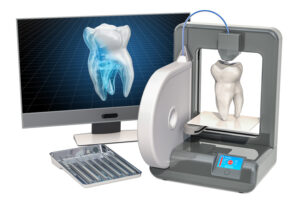
For years, healthcare industry experts have argued that dentistry remains a decade behind the rest of the healthcare field when it comes to the adoption of innovative technology. Financial constraints, a lack of time for adequate implementation and training, and a general fear of the unknown are all factors that have led to this general hesitancy. However, despite slow adoption, the dental industry has rapidly caught up in recent years. It now utilizes some of the most innovative technology to transform a core component of the provider-patient relationship: patient trust.
Dentistry’s technological revolution is altering patient trust in a way that is surpassing the rest of the healthcare sector, increasing patient trust in diagnoses, their willingness to seek care, and their overall faith in clinicians to fully understand their concerns and needs.

With the Rise of AI, What IP Disputes in Healthcare Are Likely to Emerge?
Munck Wilson Mandala Partner Greg Howison shared his perspective on some of the legal ramifications around AI, IP, connected devices and the data they generate, in response to emailed questions.
The current state of patient trust
Patient trust has historically been a point of contention within the healthcare system. This mistrust has elevated within recent years, driven by the confusion brought on during the pandemic, rising costs of care, physician shortages, diagnostic errors, and an overall lack of transparency around pricing. Around 68% of patients note their trust in healthcare has declined in the last two years, postulating the healthcare system acts out of self-interest, rather than patients’ best interest.
Dentistry has been no exception to the patient trust dilemma. It’s no secret that patients often avoid seeing the dentist due to general fear and dental anxiety. This is particularly troublesome when you consider the impact oral health has on a patient’s overall health, and its link to chronic conditions and life-threatening diseases such diabetes, heart disease, cancer, and more.
However, despite the industry’s traditional problem with trust, we’re now seeing a unique shift. Dental professionals are leveraging technology to find new ways to communicate the severity of conditions, increase case acceptance, and enhance the overall standard of care. By using innovative tech strategically, the industry is changing how patients seek dental care and elevating the level of trust patients have in both their diagnoses and their dentists’ ability to provide them with the care they need.
Innovative technologies amplifying patient trust in dentistry
While the rest of the healthcare sector seems to be experiencing an initial patient hesitance around AI, patients are welcoming the technology in the dental chair. One of the most innovative technologies strengthening the clinician-patient relationship in dentistry is AI imaging and diagnostic software. Dentists have relied on X-rays as their main diagnostic tool since the 1950s, but there is only so much the naked eye can see in these images. AI has the capability to process digital dental X-rays, benchmarking them against millions of other images to uncover details, including minute changes over time, the human eye cannot detect.
AI software not only increases diagnostic accuracy, a leading factor of patient mistrust, but it also enhances patient communication by providing clinicians with another visual aid to help patients fully understand their diagnosis. Patients are more likely to accept what they can see, what they can visualize. In fact, a survey conducted by Pearl found that 71% of patients would be more likely to trust their dentist’s diagnosis if they were using AI software to assist in X-ray evaluation.
Intraoral scanners are another advanced technology transforming the patient experience, from both a restorative and preventive perspective. Intraoral scanning enables dental professionals to create highly accurate 3D models of a patient’s oral cavity in a matter of seconds, a modernized method compared to the traditional analog impressions that cause a great deal of discomfort for patients. These precise digital impressions not only allow for better fittings of crowns, dentures, and splints, but they also elevate patient communication and treatment uptake by allowing patients to fully understand what is happening inside of their mouth.
Teledentistry and other remote solutions are also transforming how patients seek care, allowing dental professionals to meet evolving patient expectations and provide trustworthy care for patients everywhere. AI-powered smartphone scanning, for example, allows dental professionals to gather a complete picture of a patient’s oral health compared to a simple picture or look inside their mouth via computer screen. These scans can read tissue inflammation, recession, and more by benchmarking every surface of each tooth against millions of other indexed images, further supporting diagnostic capabilities and tailored treatment options.
Looking ahead
The way dentistry has embraced technological innovation to make patient care both safer and more comfortable serves as an example for the rest of the healthcare sector. Once considered an industry with a less-than-favorable reputation, dentistry is now surging ahead, and patients are starting to notice the shift. It won’t be long before patients expect the same innovation they see in their dentist’s office to be embedded within every step of their healthcare journey. By strategically embracing innovation that supports diagnoses, enhances patient communication, and meets patients where they are, we can restore patient trust in both their providers and the overall healthcare system.
Photo: AlexLMX, Getty Images
Joining Sage Dental in April 2019, April Cole has over 30 years of dental experience and has strong operational and clinical knowledge. Before Sage, she was the Vice President of Operations: East for Smile Brands before being promoted to Regional Vice President: Central for Smile Brands. April’s strengths are P&L management, problem-solving, improving operational efficiencies, and building a solid team with excellent company culture.














